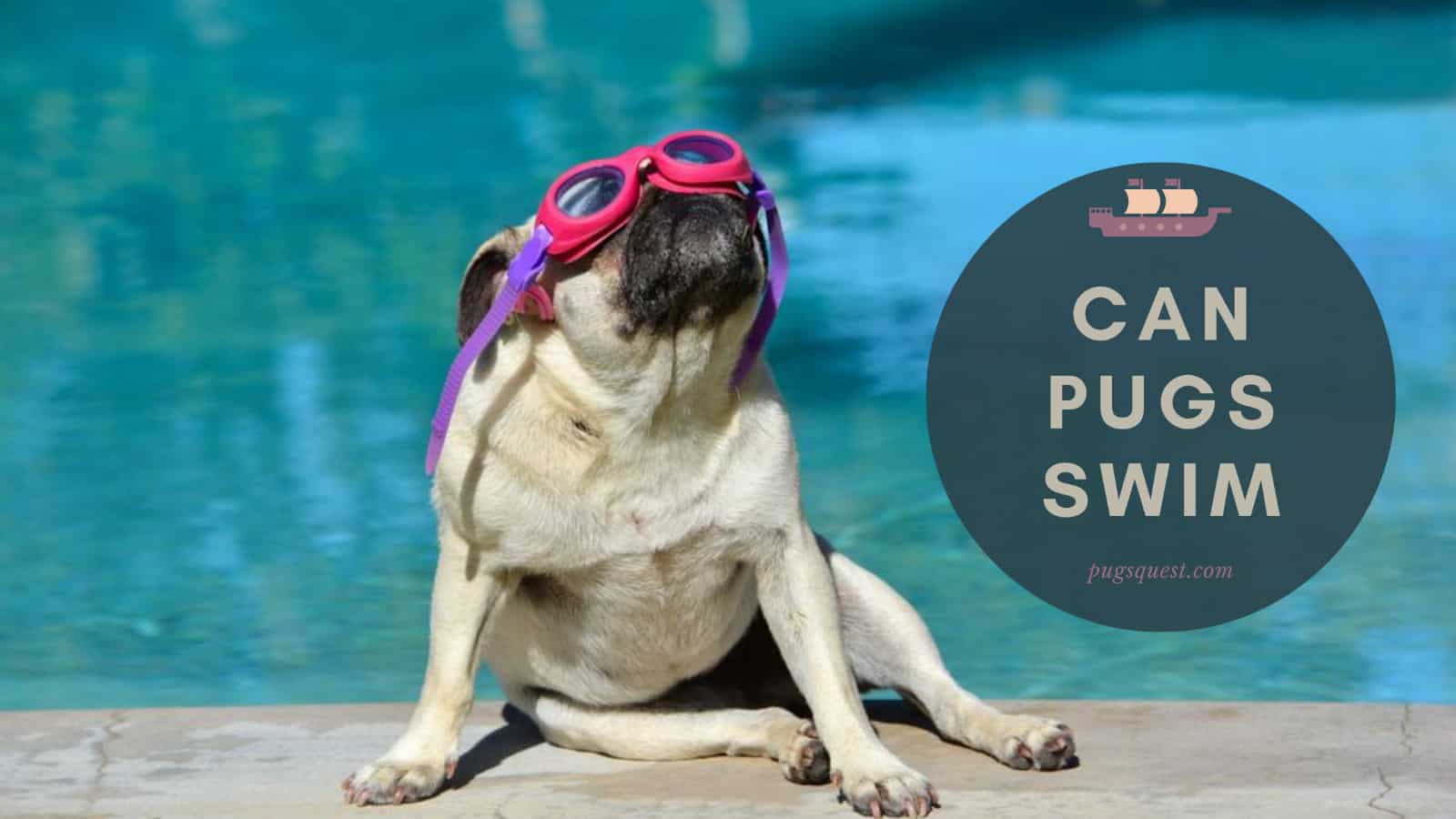Are you planning on taking your pug for a swim with you? Well, that’s cute, and it’s good you’re concerned about your pug’s safety.
And while many people believe that all dogs are natural swimmers, there are so many factors that determine whether a dog can swim or not.
Some of them include weight, breed, size, and their ability to swim.
So can pugs swim? Find out in the next section.
Are Pugs Great Swimmers?
This is a grey area because although pugs aren’t good swimmers, with a little training and safety measures, it can happen.
So, why are pugs not very good swimmers?
1. Short Snout
The pug’s appearance is one of the unique things about them.
Unfortunately, it’s also one of the factors that hinder them from becoming great swimmers.
Dogs with these physical structures are known as Brachycephalic dogs, and they include English dogs and bulldogs.
These breeds are prone to many health issues due to their small nasal passages.
Their facial structure causes breathing problems when they’re in certain unnatural positions.
Due to this physical characteristic, pugs tilt their heads upwards when they’re swimming.
This position can make it difficult for them to stay afloat.
2. Lap Dogs Trait
Pugs are among the top best lap dogs, which means they’re not half as active as other dogs. And if you’re a pug owner, you know it’s normal for them to sleep for up to 10 hours or more.
That said, pugs don’t like exerting the energy required for swimming. And they only need minimal physical activities compared to other dogs.
Experts recommend one daily walk for a pug. Your pug will love it even more if you do two short walks instead. Some pugs will be more active than others, which is fine.
However, when you take your pug for a swim, and they want to keep going. It’s advisable to make sure they take many breaks in between their swimming exercises.
3. Body Structure (small legs, long body)
The pug’s shape isn’t ideal for swimming either. They have an elongated body and short legs, both of which are a hitch to their swimming abilities.
It’s worth noting that small legs don’t automatically mean an animal is a bad swimmer.
For example, corgis have the same body structure, and yet they’re great swimmers.
The only difference is that corgis’ legs are powerful, which is crucial when herding livestock. And a lot of power is required to propel their bodies.
This can’t be said about pugs. They were not bred for retrieving or hunting, so they don’t have a powerful core or agile quickness.
Sadly, without that power, the pug’s body structure becomes a setback to them.
How to Tell If You Pug Loves Swimming?
There is a misconception that all dogs enjoy being in the water.
However, many dogs, including pugs, do not love being in the water.
But again, every dog is different, and just because one hates swimming, doesn’t mean your dog will hate it.
That said, there are some signs that you can watch out to know whether your pug enjoys being in water or not.
- For example, if you take them near a pool and they start sniffing floaties or bags and wagging their tail at the sunbathers, they might love swimming.
- If you push your pug to the water, but they refuse to get their paws wet, they might not be interested.
This doesn’t mean your pug will never swim. You’ll only need to be patient.
If your pug is still a puppy, then this is the time to start training them.
How to Teach Your Pug to Swim?
Although pugs aren’t good swimmers and can be quite lazy when it comes to exercises, they can be great swimmers with a few tips.
Before we get to the safe swimming tips, here is a small checklist that you need for pugs who are swimming for the first time:
- Make sure the lake or pool is clear from any debris
- Ensure the swimming venue isn’t crowded
- Confirm the water temperature is at least 15.55 Celsius/60 degrees Fahrenheit
Here are tips on how to teach you to swim:
1. Be Patient and Gentle When Introducing Them
Most pug owners just throw them in water, and when they stay afloat, they conclude they enjoy swimming. This couldn’t be further from the truth.
Although your pug may still afloat, it may not because they enjoy swimming but a way of protecting themselves out of fear.
And that’s not how you want the first swimming experience for your pug to be.
- Begin by luring them to enter the bathtub with treats and positive praises.
- Next, take your pug to the pool or the lake that you will be taking them for a swim to familiarize themselves with the place.
- From there, you can let your pug sniff the water and touch it. It may take time before they agree to touch the water, so don’t get discouraged.
- If you’re planning on taking them to a lake, walk around the shallow end until they’re ready.
- If they accept to enter into the water, hold them, and ensure their head is above water until they show interest in the next step.
2. Show Your Pug How to Get Out of Water
If you’re teaching your pug to swim in a pool, show them how to get out of it.
To make it easier for them, consider putting something visual such as a plant near the stairs.
This helps in ensuring they don’t feel disoriented when they’re in the middle of the pool.
Otherwise, they’ll try getting out of the pool via the deep ends, where there are no steps.
3. Never leave Your Pug in Water Alone
It’s vital to stay near your pug wherever they’re near or inside water.
NEVER leave them on their own as that’s when accidents happen.
4. Take Breaks Between the Swimming Sessions
Although pugs aren’t very vigorous when it comes to swimming or any form of exercise.
It’s essential to make sure they don’t stay in the water to exhaustion.
Pay close attention to how they feel, and make sure they take enough breaks.
5. Hire a Trainer
If your pug is hesitant to give swimming a try after all these steps or you feel the process is too complicated, consider hiring an expert.
Many local dog trainers can train your dog how to swim, which is worth your bucks if you’re planning on taking your pig for beach trips or regular boating.
When Pugs Swim: How to Keep Them Safe
Pugs aren’t good swimmers. However, there are a few things you can do to keep them safe in pools, lakes and ponds.
1. Attention to Pool Safety
Pugs are curious, so if you let them walk freely and you have a pool, it’s essential to keep them safe.
Here are tips to make sure your pool is pet-proof:
- Use Pool Covers
Pool covers are commonly used for keeping your pool from dirt, but they come in handy for protecting your pug from drowning.
When you’re not using the pool, make sure you cover it. Hardcovers are more preferred to soft covers.
The latter can be dangerous as your pug can walk onto it and end up wrapped or trapped, causing them to drown.
- Use a Pool Fence
State rules require you to have a pool fence if you have a pool. However, not every pool fence is dog-proof.
Ensure that your pug doesn’t fit between the fence. Also, cover the bottom session with plastic, and check to see if they’re making holes under the fence.
2. Get Your Pug a Life Jacket
If your pugs love being in the water, a life jacket will help them stay afloat when they fall in water before coming to their rescue.
Pug life jackets come in different sizes, so it may take you time to land on the right coat for your pug.
However, it’s worth your time and money.
3. Look Out for Chemical Reactions
Just like you, some chemicals can irritate your pug’s skin and eyes.
Give your pug 5 to 10 minutes in water and check if they’re having any reactions such as bloodshot eyes.
If your pug isn’t reacting to chlorine, you can let them have 5 to 10-minute sessions.
Precautions you can take to protect your pug from chemical reactions include:
- If you notice any reaction, wash them using fresh water and a dropper.
- Use chlorine alternatives that are pug-friendly to clean your pool
- Regardless of where you take your pug for swimming, be sure to rinse them thoroughly after swimming.
- Make sure you keep the pool chemicals, pug cables, and other equipment that hurt your pug out of their reach.
4. Lakes and Ponds Safety
If you love adventures and take your pug to swim on ponds or lakes, ensure they’re safe for humans before you let your pug in.
Some of the diseases that your pug may contract from swimming on lakes and ponds include:
- Blue-green Algae (Cyanobacteria) poisoning.
Even a cup of water with this bacterium is fatal for pugs.
Symptoms include vomiting, coma, shock, seizure, and even medication, which can still be dangerous.
- Leptospirosis.
This ailment is carried by wild animals’ urine. Pugs are only vaccinated against this if it’s considered a risk factor.
So, your pug will be at risk unless you specifically ask for the inoculation, and they’re up to date on the shots.
- Gastroenteritis related illnesses.
This is a result of pathogens and bacteria in dirty water.
If you’re considering taking your pugs to swim on lakes and ponds, talk to your vet and have your pug vaccinated against the possible ailments.
Healthy Care Tips For Your Pug When Swimming
Pugs are prone to ear infections, and being in water can cause ‘swimmer’s ear’ (Otitis externa).
This can lead to redness, itchiness, ear canal inflammation, discomfort, and pain.
The condition is mainly caused by exposing your pug in water for prolonged periods and not properly drying their ears.
To protect your pug from ear infections:
- Rinse your pug and dry them correctly by observing the grooming rules of swiping wrinkles with canine facial wipes or Q-tips.
- Next, dry your dog’s ear canal to ensure no moisture is left as it could potentially lead to an ear infection.
- If you realize your pug already has an ear infection, visit your local veterinarian. They’ll probably recommend some antibiotics.
FAQs
1. Why does my pug paddle their paw above water?
If you’ve been at the beach, or simply held your pug over water, you might have realized that they begin paddling their legs before you even put them down.
Here is why:
- Fear. This is an unnatural position for them, so they might be panicking or feeling uncomfortable.
- Reflex. Many animal traits are purely instinctive, and so is paddling. So, once your pug is above water, they may begin to paddle as a reflex.
- Learned trait. If your pug paddles and you hug them with their affection, they may associate the feedback with paddling, causing more paddling.
2. What dogs are natural swimmers?
- Spanish water dog
- Otterhound
- American Water Spaniel
- Labrador Retriever
- Spanish Water Dog
- Newfoundland
- English Setter
3. What dogs don’t love water?
- Basset Hound
- Greyhound
- Maltese
- Shih Tzu
- Pugs
- French Bulldogs
- Doberman
- Dachshund
Conclusion
Although pugs may not be the best swimmers, you can teach them how to swim.
If you decide to train your pug to swim, make sure they enjoy it and keep them safe.
Visit our blog for more exciting and informative articles about pugs.

